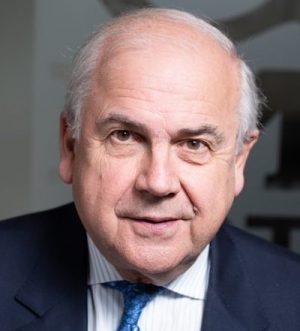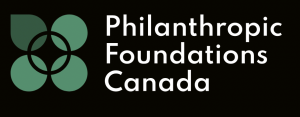
Keith Sjögren
By Keith Sjögren.
At the end of 2022, Canadian foundations held a total of $107 billion in long-term investment assets — almost two thirds of charitable sector investment assets. These assets are vital to the work and sustainability of foundations although there are some questions as to how well those assets are being managed.
One of the findings of the recent report published by Philanthropic Foundations Canada (PFC) deals with the role of investment managers in furthering the mission of a foundation (or charity), and ensuring that either personal (in the case of private foundations) or institutional values are not at odds with investments made by external asset managers engaged by the foundation.
Two Sides of the Coin

“On the flip side, it would seem reasonable to expect various foundations to include certain types of investments in their portfolios.” (Photo is courtesy of Pina Messina.)
On the surface, or obverse side of the coin, it would seem straightforward that values not be at odds with investments. MADD should not invest in companies that either manufacture or distribute alcohol; CAMH Foundation should avoid holding shares of a cannabis grower or retailer; and The Canadian Council of Churches (the home of Project Ploughshares) should avoid having any exposure through their investment portfolio to shares of weapons manufacturers.
On the flip side, or reverse side of the investment coin, it would seem reasonable to expect various foundations to include certain types of investments in their portfolios. For example, foundations aligned with the LGBTQ community should only invest in businesses that have progressive benefit programs and strong DEI policies. Similarly, foundations whose mandate is focused on the rights of children should invest in companies that manufacture in countries with protections for child labour.
Reality Bites

“Portfolio managers and relationship managers at most asset management firms are more familiar with pension management, and bring little expertise and fresh thinking to foundations.” (Photo is courtesy of Jason Leung.)
But, in reality, this is generally not happening. Foundation assets are primarily managed by firms that do not specialize in foundations and endowments but, rather, in pension fund assets or portfolios of wealthy individuals and families. Of the approximately $5.1 trillion in total assets under management in Canada at the end of 2023, pension assets represented almost 20%. High net worth assets managed on a discretionary basis made up 14%, and foundations and endowments made up just 1.5% of the managed asset pie in Canada. At the end of 2023, the largest Canadian pension manager had pension assets under management of $125 billion. That same manager, ranked second in the foundations and endowments league tables, was managing a paltry $7.3 billion in charitable assets.
The outcome of this client bias is that portfolio managers/relationship managers at most asset management firms are more familiar with pension management and bring little expertise and fresh thinking to foundations. The task is complicated by the fact that objectives of defined benefit pension funds are universal, whereas the goals of charitable foundations are customized by their purpose. To be fair, a number of major public foundations have asset management executives as directors or members of an investment committee that has led to some improvement in bridging the knowledge gap.
In terms of small public or private foundations, many engage the services of a full-service brokerage advisor who, in many cases, has no fiduciary responsibility to act in the best interests of the client and whose experience in managing charitable assets may be limited to a few accounts and a handful of donor-advised funds.
An associated concern is the near absence of professional investment guidance and management for foundations with less than $1 million in assets. Currently, based on the database charitydata.ca, of the 11,163 foundations in Canada, 61% have less than $1 million in assets with the majority of those being private foundations. (It is worth noting that over the past decade there has been a net increase of 1,335 in the number of private foundations in Canada and a decrease of 394 in the number of public foundations.) A brief survey of investment managers suggests that most do not accept investment accounts with less than $1 million in total, irrespective of the nature of the asset owner.
Those Darn Fees

“As managers encourage foundations to shift assets into private market securities to enhance returns (albeit at the expense of liquidity), fees have risen with seemingly only limited pushback from the foundations.”
A lack of specialization is one of the challenges, another is cost. The core objective of most foundations is to protect donor capital, to preserve the gifting power of the assets (as opposed to purchasing power), to have sufficient liquidity to meet both pre-determined and spontaneous granting, and to keep fees paid to external managers and advisors to a minimum in order to provide the maximum capital for charitable purposes.
Asset managers claim that fees charged to charities and nonprofits are based on fees applied to institutional investors (or private clients, if the amounts are below, say, $5 million) to which a modest discount – in the range of 10-15 basis points – is applied. While fees always reflect the size of the account and the nature of the assets being managed, there is some evidence through comparing sector average fees charged to pension funds and large foundations of similar size that the discount may not be as meaningful as some managers suggest.
As managers encourage foundations to shift assets into private market securities to enhance returns (albeit at the expense of liquidity), fees have risen with seemingly only limited pushback from the foundations. This trend of rising fees is the reverse of the wishes of the foundations. In a recent survey of foundations, 28% of respondents “strongly agree” with the statement that fees should be lower and 62% put a check mark against “somewhat agree”. To add to the sense of dissatisfaction, only 10% of the foundations surveyed were satisfied with their ability to benchmark the fees that they were being charged.
In order to offer fees that more closely meet the needs of foundations, asset managers have moved away from providing customized, segregated portfolios made up of individual securities. Instead, foundations are now offered pooled solutions for various asset classes or, in some cases, mutual or exchange traded funds. This approach seems eminently reasonable as the solutions meets the economic goals of both parties.
Influences

A nonprofit organization’s portfolio may hold investments that conflict with their mission.
What is lost, however, is the ability of the charity to directly influence what specific investments the manager holds in the pool. As a result, foundations can discover that they are holding an interest in shares issued by a business that fails to reflect the purpose of the foundation and may, in fact, have a corporate mission that is almost diametrically opposed to that of the charity. For example, Doctors Without Borders deals with the victims of war and conflict yet, within their portfolios may be an equity pool that holds a position in General Dynamics Corp, a manufacturer of advanced military vehicles.
In order to be socially responsible or to align mission and investments, foundations are asked to pay a price. Segregated portfolios carry far higher fees than pooled, exchange traded or mutual funds. Segregated portfolios that veer away from the normal models employed by asset managers to accommodate exclusions or inclusions become even more expensive. The reason is that charitable assets, although nice to have, do not represent the bread and butter for asset managers. The absence of clout and the lack of concentration of charitable assets leads to a quiet sometimes inaudible voice at the asset management table.
Options

Read Keith Sjögren’s past analysis of financial issues related to philanthropy: https://carleton.ca/panl/2023/drivers-of-philanthropy-in-2023-by-keith-sjogren
There are a range of options open to foundations, both public and private. They can accept the status quo and negotiate with asset managers for either lower fees or more tailored solutions. Secondly, the sector can identify a select group of Canadian asset managers and work with them to develop a unique offering for the charitable sector. Alternatively, they can individually (if large enough), or collectively, follow the lead of the Mastercard Foundation and the University of Toronto and establish their own asset management company and/or an OCIO (Outsourced Chief Invest Officer), such as Commonfund in the United States.
As indicated at the beginning of this article, at the end of 2022, total long-term investments of both types of foundations in Canada totalled $107 billion. Removing the $39.3 billion reported by the Mastercard Foundation and the $3.8 billion of endowed assets at the University of Toronto, leaves a total of $62.5 billion. While this may be a modest amount in both relative and absolute terms, it is an amount big enough to attract attention, whichever option is selected. The importance of the charitable sector to Canadian society cannot be measured by the size of investment assets.
The key to improving the manner in which charities are perceived and managed by asset managers is to work together to force change and not to try and address the shortcomings on an individual basis.
Investing for Impact
 The report from Philanthropic Foundations Canada also highlighted the interest of many foundations – most likely private foundations – in moving a larger share of their investment portfolio into social or impact investments. This laudable strategy is not hard to establish but far from simple to implement.
The report from Philanthropic Foundations Canada also highlighted the interest of many foundations – most likely private foundations – in moving a larger share of their investment portfolio into social or impact investments. This laudable strategy is not hard to establish but far from simple to implement.
One reason why there seems to be foot dragging on this matter, despite evidence that some major foundations are taking bold steps, is the unpreparedness of, or lack of interest by, conventional asset managers to provide opportunities and access to impact investments. As a result, a new breed of impact investment managers and advisors is emerging.
However, despite the heightened public awareness of social finance – of which impact investing is one element – following the creation by the federal government of the $755 million Social Finance Fund, and notwithstanding a growing body of research, there remain some high hurdles to jump before a robust impact investing infrastructure is put in place.
High Hurdles

“The task of the community of Canadian foundations is to determine ways to deal with these hurdles not to stop entering the steeplechase.” (Photo is courtesy of Darren Wilkinson.)
These hurdles include attracting nationally focused foundations, such as those that offer donor-advised funds, to consider what are generally local and small opportunities that, for one reason or another, may not be supported by their donors. Secondly, the very nature of impact investments, often, but inaccurately, compared to venture capital, may generate an annual rate of return that is well south of market rates of return, not to mention the disbursement quota (5%) which has become the focus of many foundation boards and investment committees. Thirdly, along with a sub-market rate of return, impact investors must accept high transaction costs, a lack of liquidity, greater risk, transactional complexity, and a lower level of regulatory involvement, all of which may have a negative impact on the ability of the foundation to deliver against its primary mandate.
The task of the community of Canadian foundations is to determine ways to deal with these hurdles not to stop entering the steeplechase. The funding developments that have taken in place in the charitable sector and the creativeness of leaders lead to the conclusion that bold steps can be taken to unlock what many observers still categorize as idle capital. This is capital that was originally accumulated for social good and but needs to be freed from the bounds of low risk, conventionally managed investments that are mainly held in non-Canadian businesses focused on returns to shareholders and not benefits to Canadians.
Keith Sjögren is Chair of the Advisory Board for the Philanthropy and Nonprofit Leadership program and a member of the Donor-advised Fund Working Group of the Canadian Association of Gift Planners. Keith is also a member and former Chair of the Investment Committee of the Centre for Addiction and Mental Health Foundation.
Sign up for PANL Perspectives, MPNL’s free newsletter.
Wednesday, October 23, 2024 in For homepage, News & Events, Private Foundations, Social Finance
Share: Twitter, Facebook



